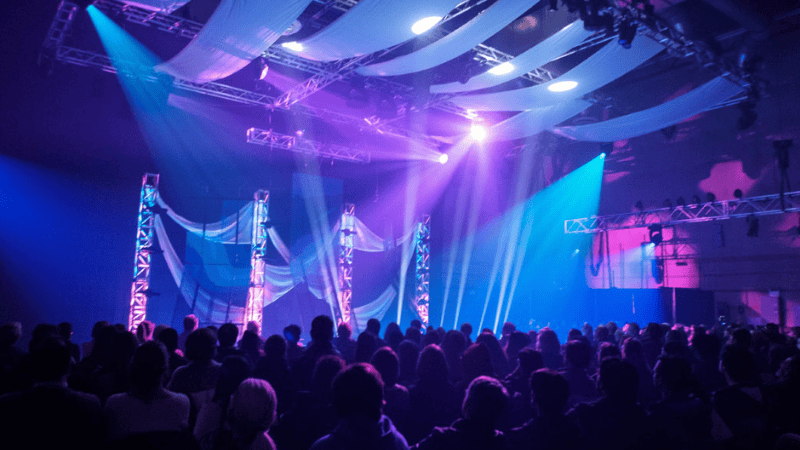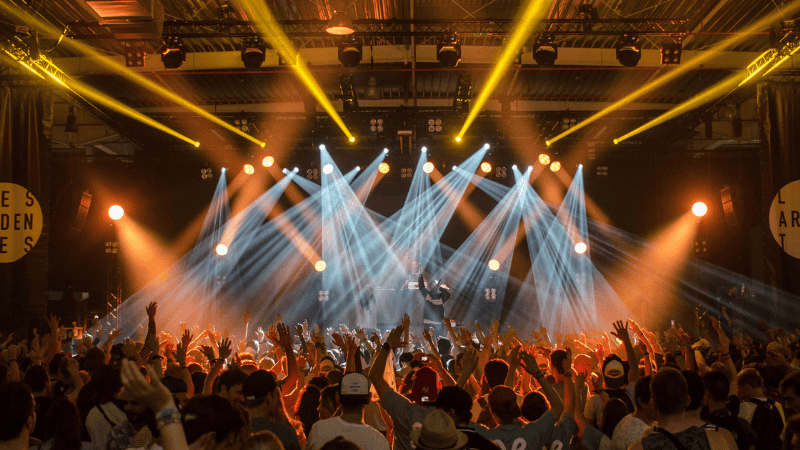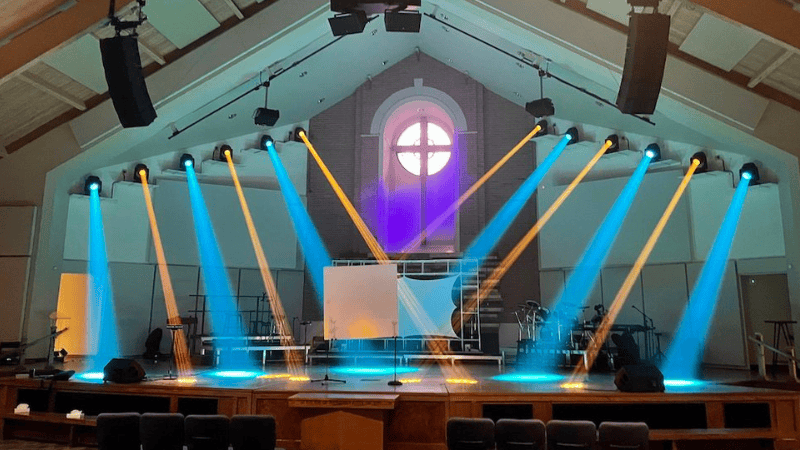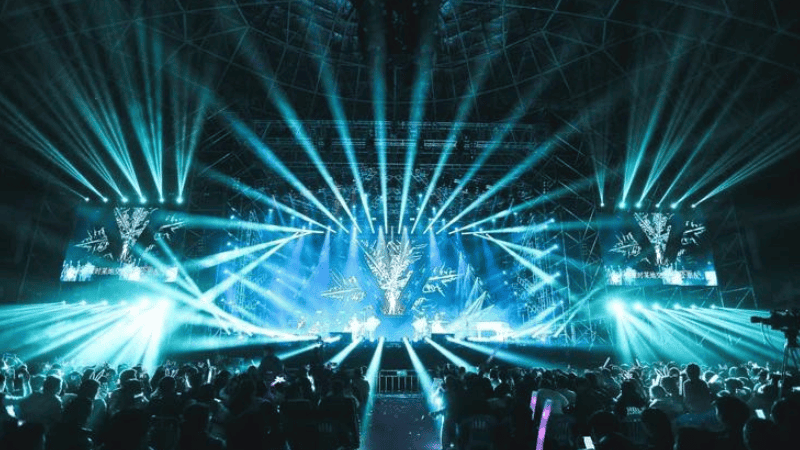Stage lighting significantly impacts any performance, whether it’s a dance show, theater, or concert. The suitable lighting not only increases the overall appeal of the performance but also adjusts the tone and mood of production by the performance.
Stage lighting, from the spotlight to intricate designs, can increase the audience’s interest and add life to the performance.
Are you looking for the ideal lighting solution for your next stage performance? In this guide, we will discuss everything from the basics of stage lights, their purpose, and elements to how to incorporate them effectively. So, let’s dive in!

What Is Stage Lighting?
Stage lighting is not merely about illuminating performers on the stage. It’s a potential tool for attracting audience attention to the performance’s specific design elements and key features.
Perfect stage lighting serves multiple purposes. It increases visibility, ensuring the audience can see every intricate detail, expression, and movement of performers.
It also enhances performances by highlighting or changing tones during intimate speeches and dramatic peaks. Moreover, stage lighting makes it convenient to show time passage without changing the set.
Beyond the spontaneous visual effects, proper stage lighting equipment fixtures have certain potential benefits like improvement in the overall quality of the performance.
Ask For Free Quote
Let us Respond Promptly for your Needs :)
The incorporation of effective lighting makes the performance memorable and engaging for both the audience and performers. It can transform a simple stage into an immersive, dynamic space where every light tone narrates a different story and adds emotional impact to the performance.
Furthermore, subtle bright lighting can add dimensions and depth to the performers’ skills and highlight craftsmanship. In educational institutions, using principles of stage lights can effectively increase students’ learning experience because they can visualize presentations or storytelling performances with more focus.

The Power of Colors In Stage Lights Design
While talking about the importance of stage lighting, we can never ignore the key role of lighting colors. Colors have a potential impact on human psychology and emotions. That’s why using different colors in stage lighting accordingly can enhance the emotional impact of your performance.
Warm color tones such as red, orange, and yellow represent energy, excitement, and passion. Such colors are used in stage lights to create a sense of intensity in high-energy performances.
On the other hand, cool colors such as purple, blue, and green represent serenity, tranquility, and calmness. These colors are often used in performances to make the atmosphere more emotional and sensitive.
But picking the right color does not just make a performance hit you right in the feels. It’s also about how those colors mix and come alive on the stage.
Picking the right color combos can really make your performance pop and leave a strong visual impression. You can also get the help of a professional lighting designer to choose the right LED stage lighting.

Types of Stage Lighting Fixtures
After knowing the importance of stage lighting, you must be curious to know the main types of stage lighting and how they work together. There are three main lighting options suitable for stage performances.
Here is a brief discussion of every type and how you can use that type in your stage lighting design process:
Floodlights
Floodlights are the most common type of lighting fixtures used in stage production. They are also known as area lights or flood washes. These moving lights offer a uniform distribution of light over the complete area of the stage.
Due to this wide lighting function, floodlights are usually positioned at higher positions above the stage or on the sides.
Moreover, floodlights are also useful in creating general lighting for a complete scene or a specific area on the stage. They are also impactful in creating a wash of color over the stage, adding inviting appeal and depth to the performance atmosphere.

Spotlights
Spotlights, also known as hard-edge lights, are focused beams useful in precisely directing or controlling light in a particular area. Such lights often highlight speakers, performers, or a specific area on the stage. For instance, spotlights follow and highlight the dancer’s every move across the stage during a dance performance.
To use spotlights effectively, you must know how to control light shape, size, and intensity. Lenses and filters of different colors can help you create a stunning visual effect with high precision on the stage.
Ask For Free Quote
Let us Respond Promptly for your Needs :)
Wash Lights
Like floodlights, wash lights are also focused but with better precision and softer light. Such lights are used to create a subtle, ambient lighting effect on the performers. Moreover, wash lights can also highlight dancers, performers, speakers, or specific areas of the stage.
The potential advantage of using wash lights is their versatile nature and ability to transition from general to specific lighting effects with every changing scene. This feature of wash lights makes it mandatory to be added to your stage lighting design plan.

How to Apply the Right Stage Lighting For Your Stage?
After having a brief overview of the purpose and different varieties of stage lighting fixtures, let’s explore how we can use them in the best possible way. Some suggestions for creating an alluring and effectual stage lighting design are below:
1- Lighting Positions and Angles
In stage lighting design, mindful placement and angling of lights are important. Every particular position plays a very effective role in setting the mood, boosting performance, and creating depth and dimension on stage. So, a basic understanding of these positions and angles can play a constructive role in stage lighting design.
- Front Lighting:
The main purpose of front lighting is to enhance the visibility of performers for the audience. This will help the audience have a well-lit and clear view of the stage and reveal details such as the facial expressions and costumes of the performers.
This is crucial for connecting the audience to the performers. But complete reliance on front lighting can give a view with no dimensions and depth, making it less attractive.
- Backlighting:
Backlighting is important to highlight the background of the stage and outline the performers from their background. This technique creates a three-dimensional view, making it appealing to the audience. It can also be used to create a dramatic effect for the audience.

- Side Lighting:
Side lighting can enhance textures and shapes, particularly for dance and physical theatre performances. It adds a layer of visual appeal and dynamism to the stage, highlighting the movements and generating dramatic shadows.
- Top Lighting:
Top lighting can effectively accentuate the top of the stage. This technique can give the stage an aesthetic and charismatic appearance. As it is on the top of the stage, it can stimulate natural light, adding realism to the scene.
- Front and Side Lighting Combinations:
Combining front and side lighting can add depth and texture to the stage and the performance, giving it a dynamic contrast. It can also be beneficial as it highlights the performers’ facial expressions and movements, giving the audience a very energetic vibe.

2- Selecting the Stage Lighting Fixtures
Be mindful while selecting stage light fixtures, as it can greatly affect your stage production’s overall look and feel. The types of lighting fixtures you choose can significantly impact your stage production’s overall look and feel. The characteristics and different colored lights need to be understood before making a choice:
- LED Lights: Features like energy efficiency, versatility, and dynamism make LED lights the best choice. They are available in various colors and textures so you will have a wide range of options while selecting. These lights can be controlled remotely making possible quick changes during performance.
- Incandescent Lights: The light produced through Incandescent lights gives warm and natural light effects and highlights skin tones. These are also economical and simple to use. These properties make incandescent lights a good choice, especially for small-scale productions.
Ask For Free Quote
Let us Respond Promptly for your Needs :)
- Moving Head Lights: Moving headlights are polytropic and highly personalized. These lights are also known as intelligent lights. They are available in various colors, shapes, and patterns, making them the best choice for creating dynamism on stage.
- Gobo Lights: If you wish to project intricate patterns or images on the stage, you should use Gobo lights. These lights use a specialized lens and placed in front of a light source to produce patterns and images. This is an excellent technique to create mesmerizing visual effects.

3- Don’t Forget About the Lighting Color Palette
The right colors for your lighting design can enhance the overall aesthetic sense of your performance and set the audience’s mood. Colors can evoke particular emotions and have a greater impact on the audience’s perception.
- Monochromatic: Monochromatic lighting uses different shades of the same color to create a cohesive and understated look. If you want to create a specific mood or atmosphere, you can use this lighting color palette, such as a somber scene with blue lighting.
- Complementary: Complementary colors are those that are opposite each other on a color wheel. These colors create a spectacular effect and a high contrast. For instance, pairing red and green lighting can create a feeling of excitement and energy.
- Analogous: The colors adjacent to the color wheel are analogous and create a melodic blend of colors. This technique creates a euphonic and realistic look, such as using shades of yellow, orange, and red for a sunrise scene.
- Cool and Warm Colors: Cool colors, such as blue and green, create a sense of composure and tranquility, while warm colors, like red and orange, evoke warmth and affinity. Understanding the impact of cool and warm colors can help you create the right mood for your performance.

Common Mistakes to Avoid While Designing Stage Lighting
Stage lighting design can be exciting, but be aware of common mistakes that can reduce the effectiveness of your design. The following are some suggestions to avoid such mistakes and ensure an effective lighting setup.
1. Overcomplicating Designs
Incorporating many elements in a single lighting design can make it look cultured and confusing. This is the common mistake that most lighting designers make. The important thing to remember is that you can create an amazing and impactful look with simple methods without overcomplicating your design.
2. Neglecting the Performers’ Needs
The comfort and needs of performers are the basic things that should not be neglected while designing stage lights. Their safety and visibility are crucial to boosting their performance and avoiding risks.
3. Forgetting About the Audience
Never forget the audience because their experience is as important as the performers. Consider which lighting designs and colors will increase visibility for the audience, and avoid using lights that distract the audience’s attention.
4. Failing to Test and Rehearse
It’s also important to test and rehearse your lighting design and setup before the actual performance. This helps ensure that everything goes smoothly as per the requirements, and you can make adjustments if needed to make the real performance heart-stealing.
Ask For Free Quote
Let us Respond Promptly for your Needs :)
Illuminate Your Stage with LED in an Eco-Friendly Way
It has been observed that the entertainment industry is shifting more toward sustainable and environment-friendly practices. LED lights have become a top-notch choice of producers for stage lighting because of their high-quality illumination, longevity, and energy efficiency.
Let’s explore the following key reasons why you should use LED lights for your stage performances:
- LED lights consume 80 percent less energy than traditional incandescent bulbs and are more cost-effective and eco-friendly.
- Energy-efficient lights emit less heat, enhancing performers’ comfort by keeping the stage cooler.
- Due to the durability of LED lighting control systems, they need less frequent replacements, leading to less waste and low maintenance costs.
- Another advantage of LED lights is their smaller size, making them easier to transport and set up for touring productions.

Conclusion
Stage lighting is essential to any performing arts production, whether theater, drama, film, or dance. Understanding some basic techniques and principles of stage lights can enhance the overall impact of your performance.
Consider color palette, fixture selection, and lighting placement wisely to create a dynamic and stunning visual stage that complements the emotions and movements of your performers.
Remember to consider the needs of the audience and performers while experimenting with creating an attractive lighting design. With the right approach and knowledge, you can elevate your performances to a new horizon and leave a long-lasting impression on the audience.
Have a Spotlight-Worthy Performance With RC Lighting
At RC Lighting, we provide multiple stage lighting options to fulfill all your production and performance needs. We have a team of expert lighting designers who can provide you with assistance and consultation in designing the spectacular lighting setup for your stage, theater, or production.
We have everything from LED bulbs to GOBO lights and moving heads to make your show unforgettable.
So, whether you are looking for custom lighting solutions for a specific performance or simply want to update your current lighting tools, RC Lighting has you covered. Contact us today, and let us help you shine on stage!



